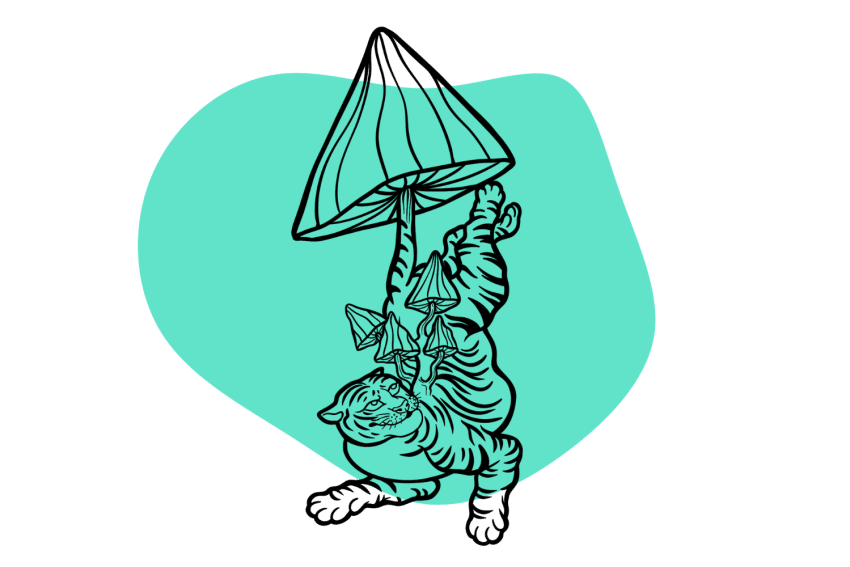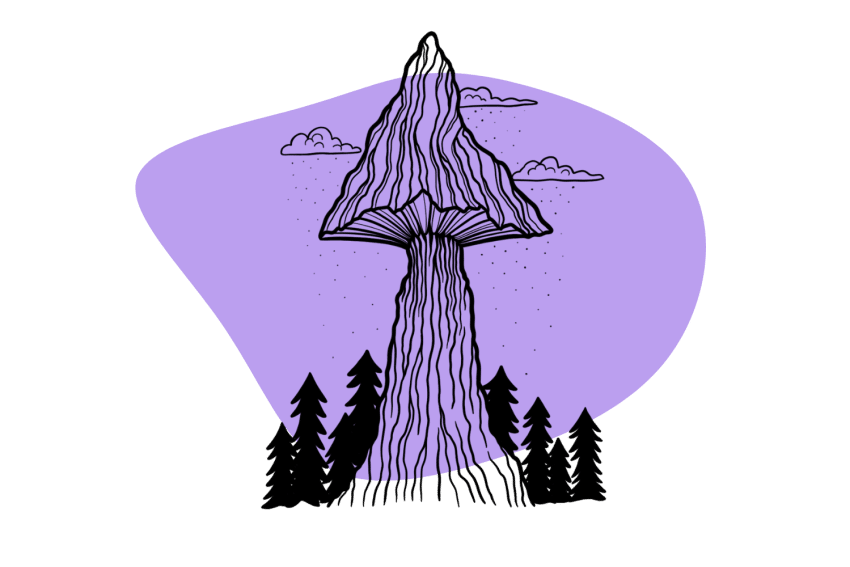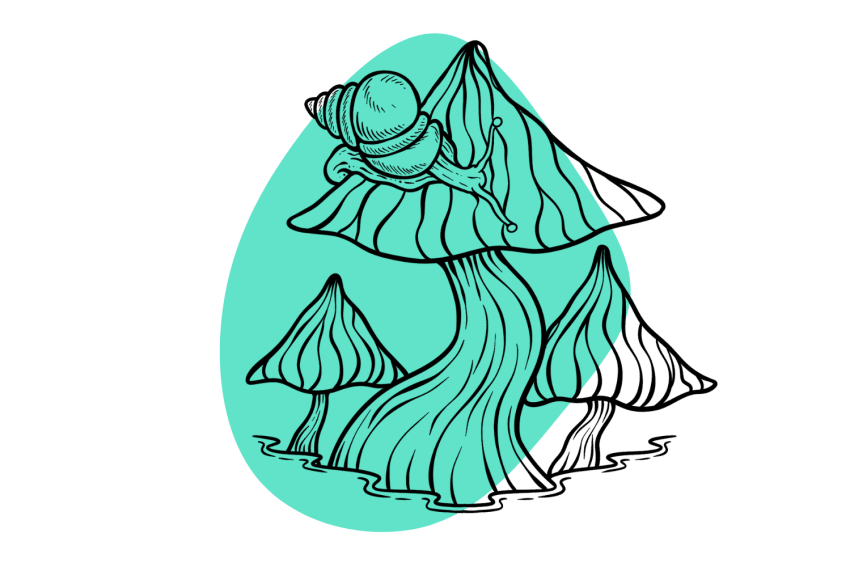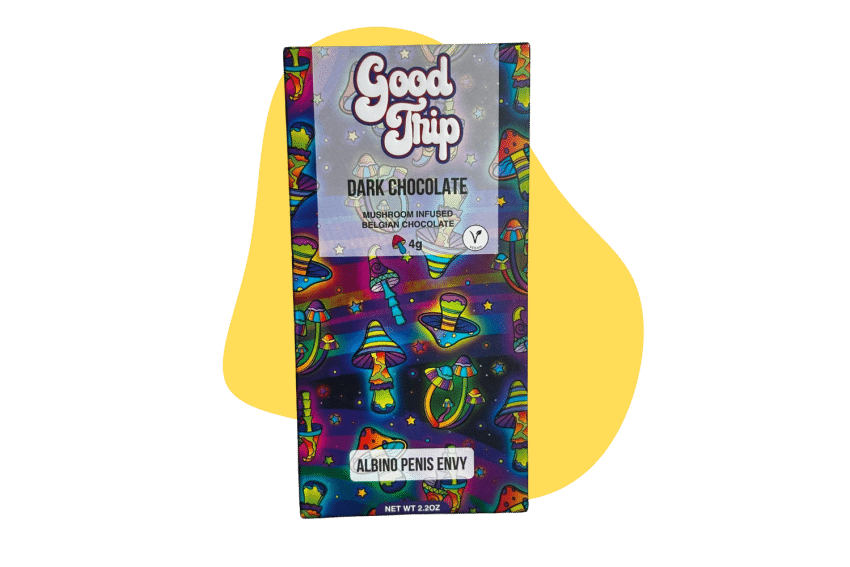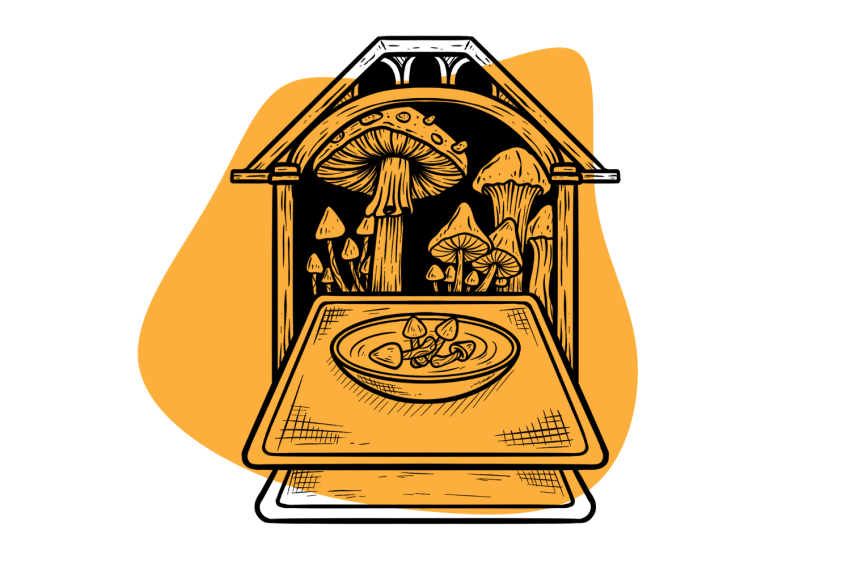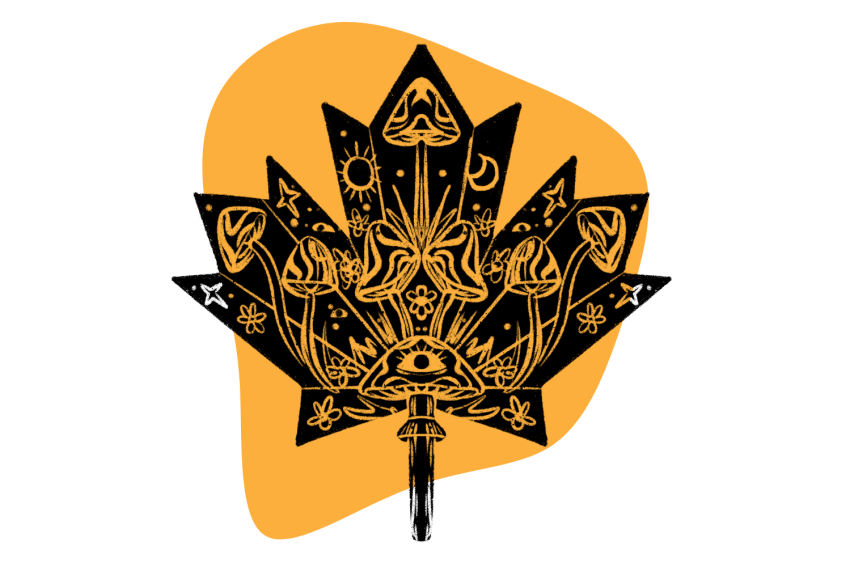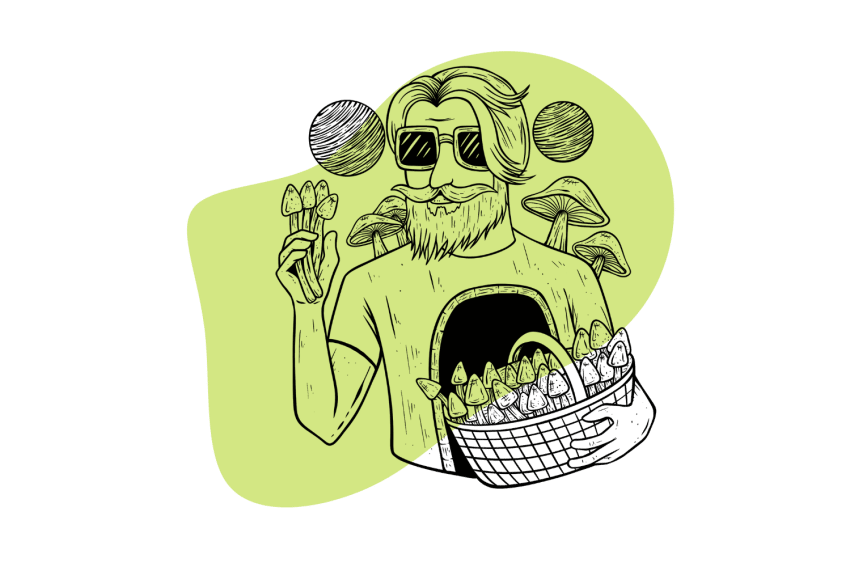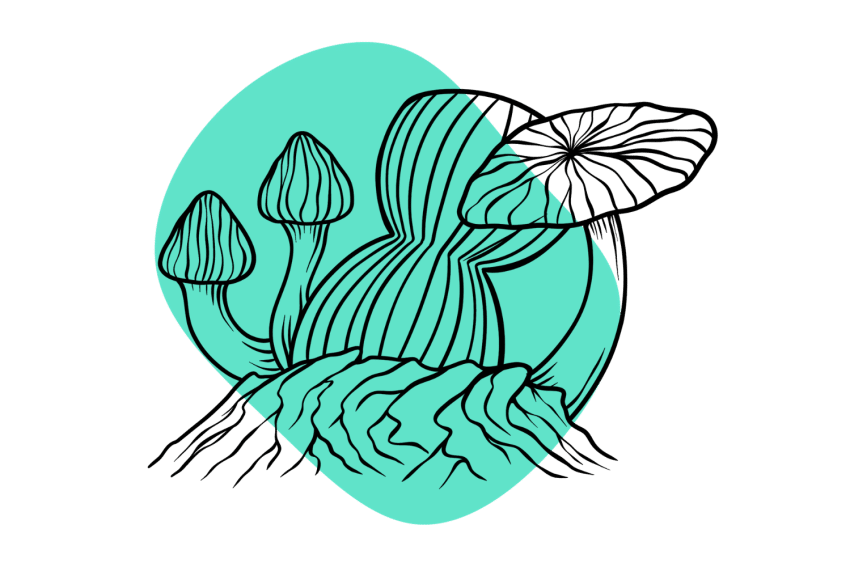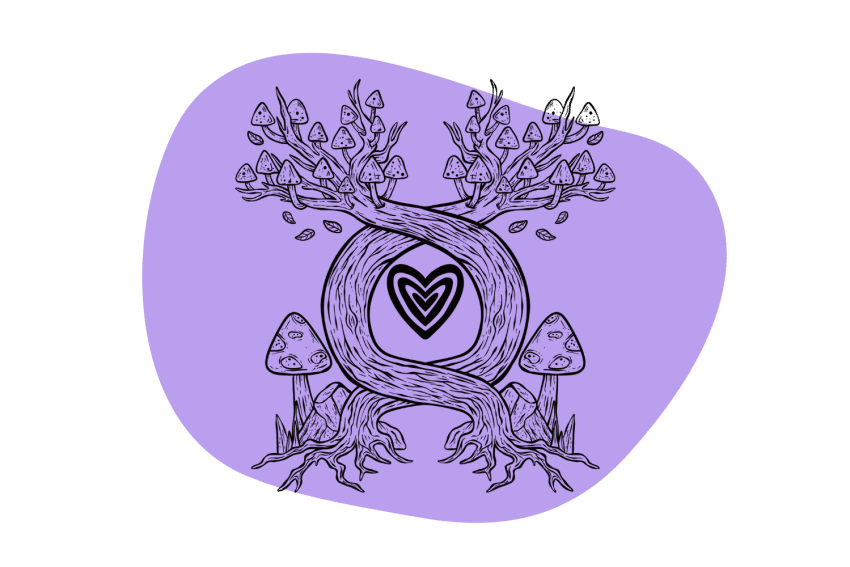Magic Mushroom Art: Hallucinogenic Historical Art, Famous Artists & Psychedelic Artworks
From cave paintings to social media feeds, people have been making mushroom art for a surprisingly long time.
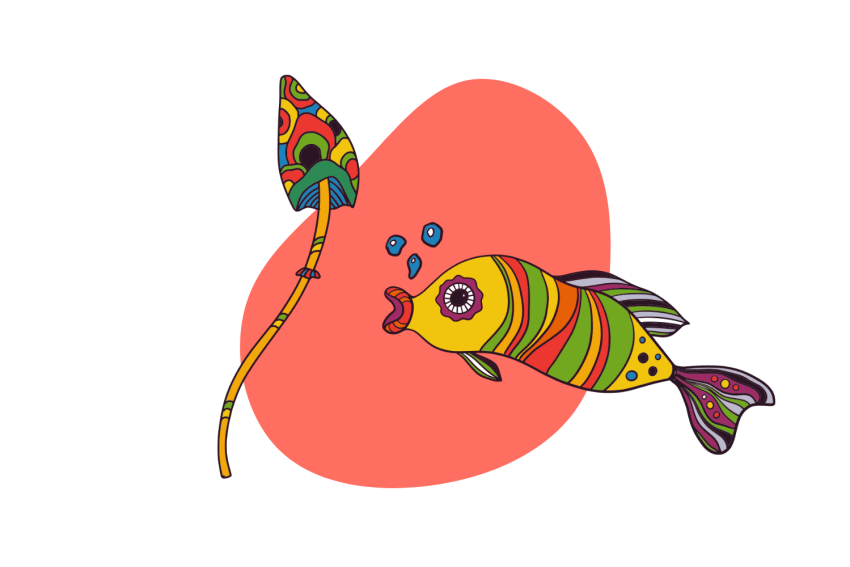
Psychedelic mushroom art has a long history. Although mushrooms and the mycelial network date back over a billion years, evidence of mushrooms appearing in art spans at least 10,000 years. Funny fungi have shown up in early cave paintings, which often illustrate the hallucinogenic and medicinal properties rather than the shrooms themselves.
Today, artists and novices alike are creating truly psychedelic artworks like sketches or psychedelic-inspired movies, either influenced by the effects of magic mushrooms or created during mushroom trips.
These artistic creations showcase the visual and auditory hallucinations induced by magic mushrooms and pay homage to the sacred, consciousness-awakening possibilities that mushroom trippers experience.
Trippy Mushroom Art on Instagram
What better place to look for art inspiration than Instagram? You’ll find everything from pottery and ceramics to painting and sketches.
Follow the accounts below for regular doses of mushroom art inspiration.
@trippypainting
@edamewok
@chelseazoart
@mushroomzen
@breadandbadger
@npb.spectrum
@triangelfanny
Historical Psychedelic Mushroom Art
Historians have identified images of mushrooms in cave paintings and petroglyphs across cultures dating back as far as 10,000 B.C. around the beginning of the Holocene period, as well as the Mesolithic-Neolithic periods about 8,000 years ago. These are some of the oldest known representations of hallucinogenic mushrooms worldwide.
Many of these historical representations of mushrooms have been found in cave drawings on different continents. This suggests that the use of mushrooms was prevalent and, perhaps more importantly, shouldn’t be considered taboo; our ancestors have been using mushrooms for millennia [1].
One prevalent theme across almost all prehistoric mushroom art is the depiction of wild animals and natural vegetation alongside mushroom imagery. Instances of fish, bulls, and other mammals or wildlife coincide in almost every drawing. If animals aren’t present, trees, geometrical plant patterns, or other fauna are included instead.
Some of the pieces showcase mushroom people, where human heads have been replaced with mushrooms. Although all art is subject to interpretation, heads-as-mushrooms do seem to have a clear link to the psychoactive effects one experiences after consuming psilocybin mushrooms.
Historians have yet to discern the strains of mushrooms shown in the ancient works, as it’s unlikely that our ancestors were exploring tribal practices with penis envy, one of the trippiest mushrooms. But, at a time when very little, if anything at all, in the world was industrially processed, a small dose of psilocybin probably took people of the stone age very far out!
What we do know is that mushroom motifs in ancient art are likened to an archaic, natural world where the use of these plant medicines was likely spiritual, mystical, or religious. One archaeologist, Henri Lohte, claimed, ‘it seems evident that the [cave paintings] were secret sanctuaries’ [2].
A few examples of appearances of mushrooms in ancient art include:
1. Siberian Mushroom Gatherers
Petroglyphs of mushroom gatherers wearing ornate mushroom-inspired regalia appear in the caves of Siberia’s arctic circle. Historians suggest these images likely depict hallucinogenic use of the mushrooms associated with Eurasian shamanism.
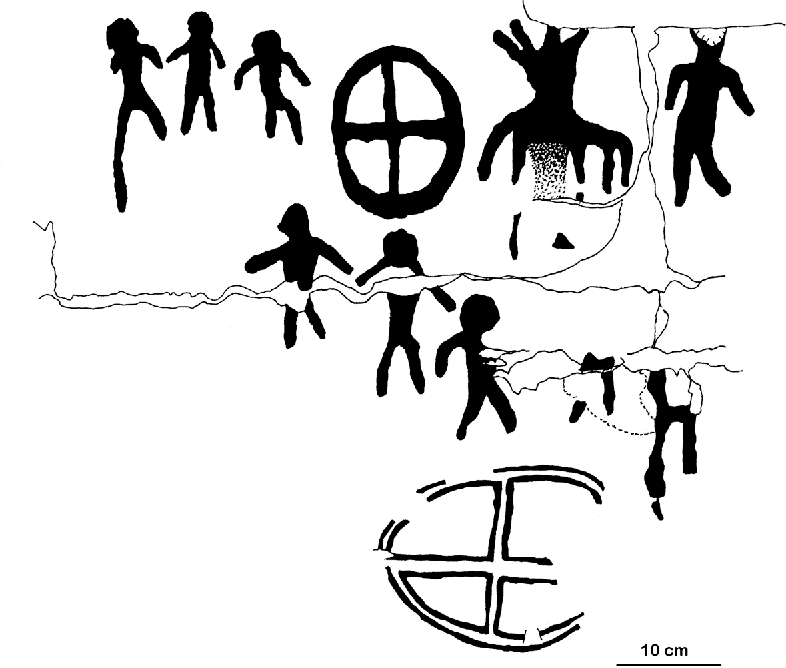
2. North-African Psychonauts
In the Sahara Desert of northern Africa, rock art and rock shelter art images capture fantastical, ecstatic images of the natural world at the time, around the Holocene period, directly after the last major ice age. Many experts agree that the forms appear to be depictions of hallucinogenic states.
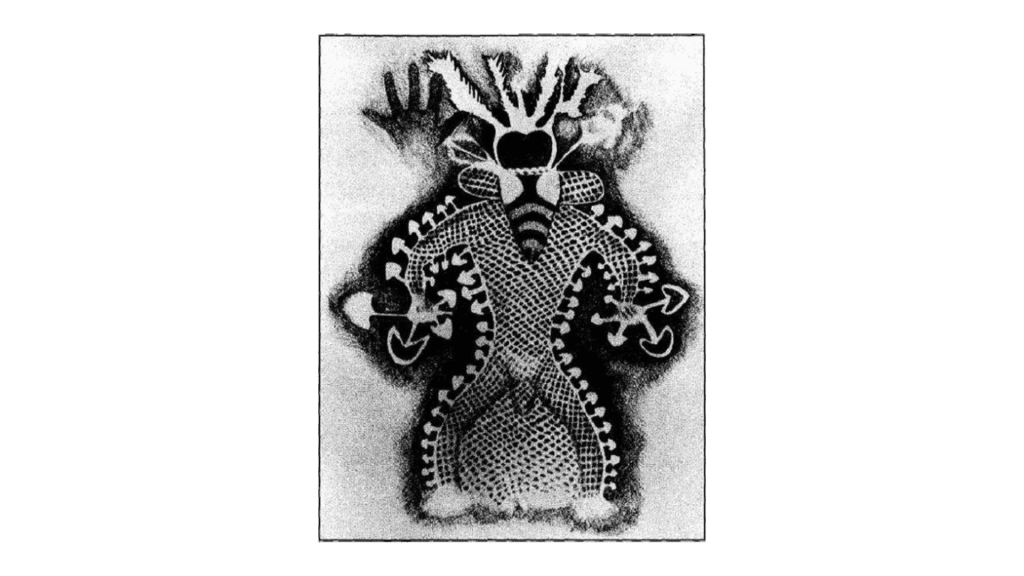
3. Spanish Mushroom Rituals
The Selva Pascuala prehistoric archeological site in northeast Spain depicts post-paleolithic magic mushroom use for ritual experiences. Two 8,000-year-old panels found inside a cave feature a ‘mushroom mural’ showing mushroom caps as part of an ancient traditional practice.
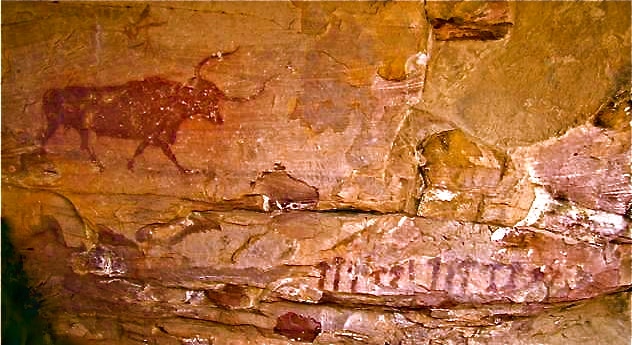
Modern Magic Mushroom Art
Fast forward a few thousand years, mushroom symbolism remains a prevalent theme in artistic creations, even throughout the last 500 years. The last 60 years have been called something of a psychedelic renaissance since the 1960s as hallucinogens gained traction in mainstream culture and trippy creations have come booming back.
Mushrooms in Modern Art Works
Mushrooms have been depicted as both sacred, epiphany, or spiritual awakening inducing, and conversely as demonic, satanic, and sinful throughout modern history.
One example of the shameful representation of psychedelic mushrooms can be seen in Hieronymus Bosch’s famous triptych work of art, The Garden of Earthly Delights.
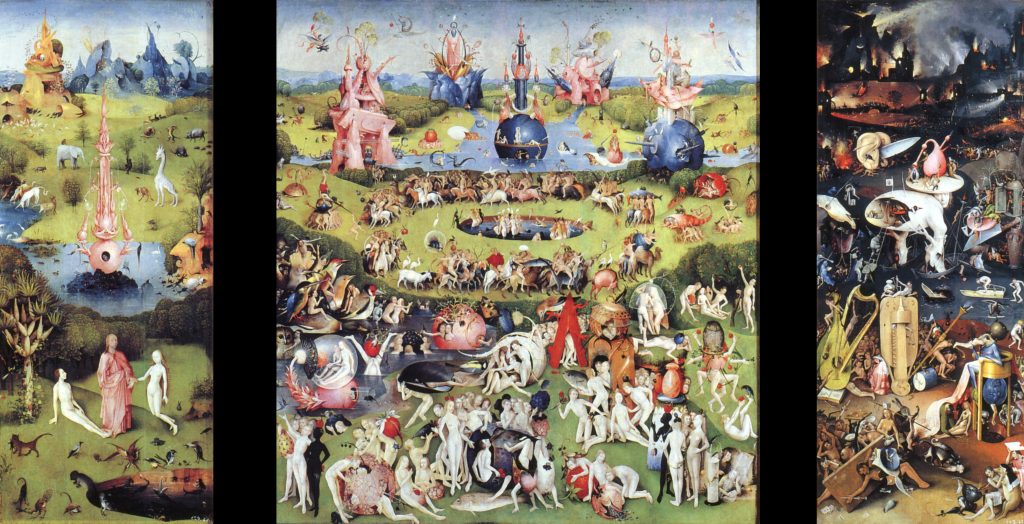
The piece is associated with Christianity and presents themes of temptation, as seen in Adam and Eve. The work is a ‘depiction of the fate of humanity’ through sin. It’s filled with hallucinogenic imagery and fantastical, imaginative, idyllic scenes. However, the final panel showcases hell in what can only be presumed to be a ‘bad trip’ with dark colors, shadows, and fearful figures.
Mushroom Motifs in Baroque Art
Mushrooms appeared in paintings and sculptures from the Baroque period throughout what is now called north-western Europe, starting in the 1600s. These were often still-life images that showcased mushrooms as food rather than showcasing their psychedelic properties, but perhaps the representation is more nuanced than it appears.
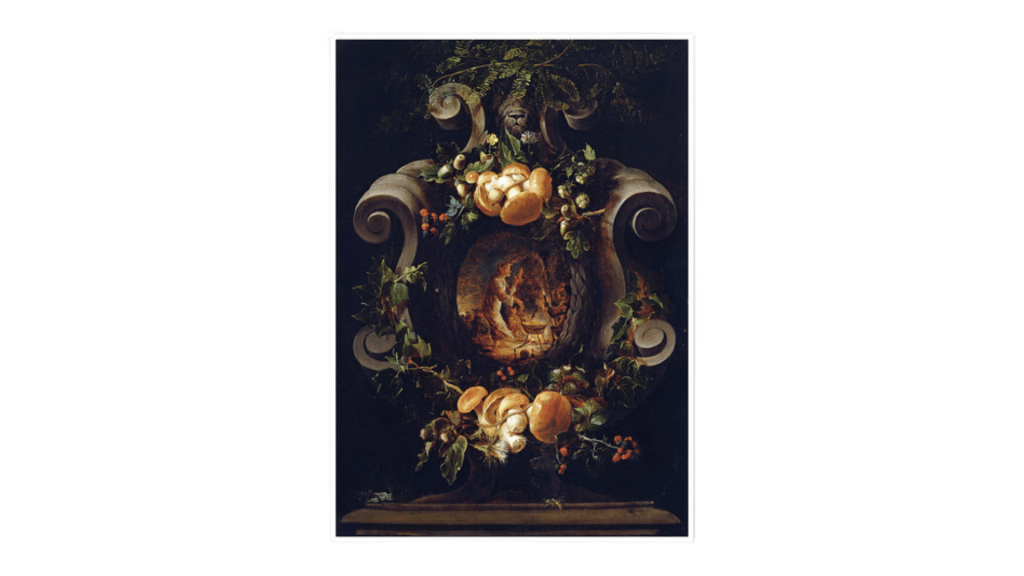
Examples of this can be seen in works by David Teniers the Younger (the 1600s), including images of witches in sorcery practices, where mushrooms are visible.
Fungi in Victorian Era Arts
Mycelium appeared in Victorian-era paintings during the 1800s, with fantasy imagery including fairies, gardens, and other trippy, natural scenery. Some historians suggest that during this era, opiates were also part of popular culture and may have influenced the artworks alongside psilocybin mushrooms, as seen in the watercolor, A Fairy Ring by Walter Jenks Morgan from the 1870s.
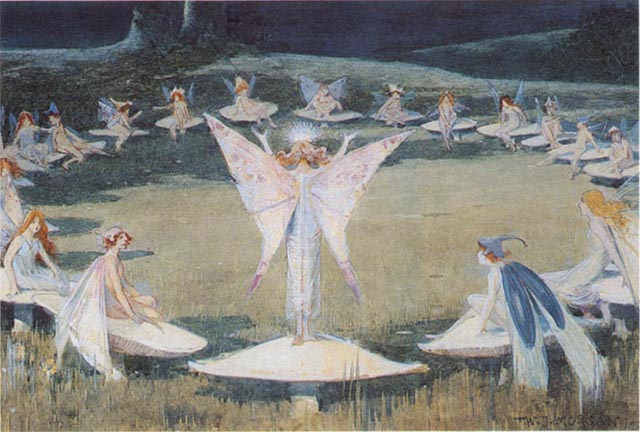
Information about the appearance of mushrooms in North American art throughout history can be found in the art registry of the North American Mycological Association.
Contemporary Cosmic Art
Mushrooms and fantastical fungi continue to appear in the art of today, called Contemporary Art. This period encompasses works from the late 20th century and early 21st century.
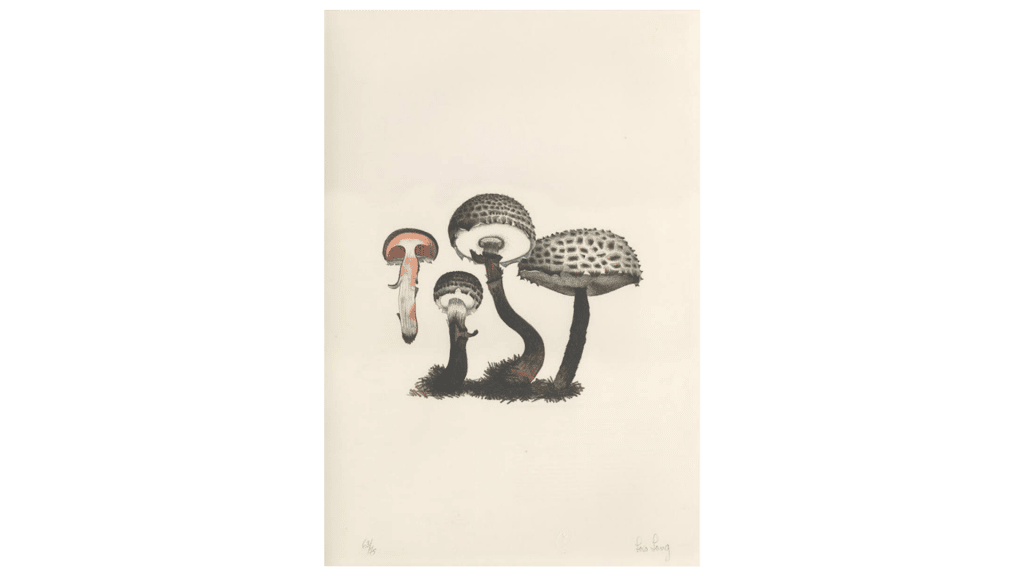
John Cage is a great example of a contemporary artist whose work showcases an affinity for mushrooms and their potential psychedelic effects. The self-proclaimed ‘Mushroom Hunter,’ Cage captures both artfully and in earnest, images of fungus. Many of these images can be seen in his 1972 collection, Mushroom Book, a composition of photographs, illustrations, maps, poetry, and other artistic endeavors.
Famous Magic Mushroom Artists
Various contemporary artists became famous for their psychedelically inspired works.
Whether they used hallucinogens to visualize and imagine the imagery, tried to capture the essence of the hallucinogenic experience through their art, or simply created images likened to the lichen is not always clear. However, they achieved their psychedelic artist infamy; check out these artists who are well-known for their psychedelic style.
Jackson Pollock
Jackson Pollock was an artist in the United States born in the early 1900s. His abstract ‘all over’ or ‘drip paintings’ are both colorful and monochromatic.
They depict vast webs and spirals that could be representative of mushroom trips and representative of the mycelium network itself, which is often understood to appear as an organic pattern. This is similar to the Fibonacci sequence, or nature’s golden ratio, which is a commonly cited experience of the visual hallucinations of geometric shapes seen during a mushroom trip.
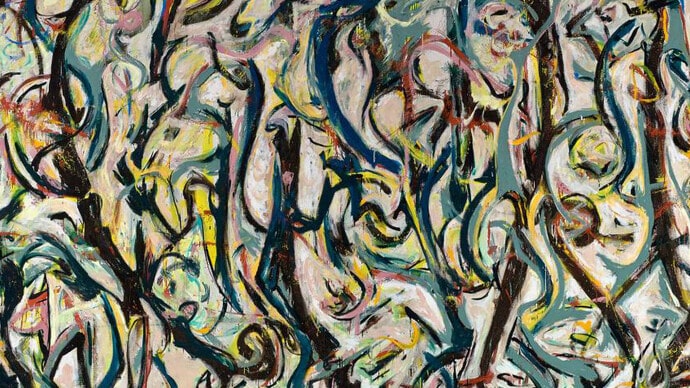
Pollock was known to use a technique called frenetic dancing, which uses the entire body to apply paint to a canvas.
His abstract approach to creating art, paired with the vividness of the works themselves, land Pollock on the shortlist of trippiest painters.
Cy Twombly
American painter Cy Twombly, both directly illustrated mushrooms and demonstrated tendencies toward psychedelic trips throughout his body of work, created from the mid-1930s through the early 2000s.
Twombly’s abstract and psychedelic aesthetics are representative of a profound connection to nature, such as that acquired through his artistic process of mushroom hunting before painting [3].
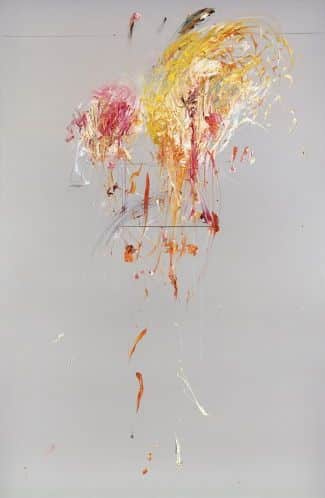
His artwork is also a great example of a common hallucinogenic experience of synesthesia, a perceptual experience where visual, auditory, and sensual cognitive pathways intermingle. This creates a distorted experience of sound as color, feeling as a sound, etc. [4].
Upon viewing Cy Twombly’s work, one can sense these synthetic qualities and fall right into flashbacks of tripping out.
Andy Warhol
Warhol, leader of the famous Pop-Art movement, demonstrated not only abstractions on paper but was also a multimedia artist, constantly pushing the boundaries of perception and comfort for viewers.
Many of his works featured psychedelic colors and loud and repetitive images that resemble hallucinogenic mushroom trips.

As with his contemporaries, the role of psychedelics in his artistic process is not entirely clear, but if the creative explosions of his artwork are a testament to magic mushroom use, one could say Andy Warhol was surely on a trip.
Salvador Dalí
Salvador Dali once stated, “I don’t do drugs. I am drugs.”
Interpret this as you wish, but Dali was one of the most famous abstract artists of the modern art movement.
His surrealist paintings are imaginative, fantastical, remarkable, and downright bizarre. The trippy nature of Dalí’s artworks often leads viewers to think he used psychedelics throughout his creative process, but he and his colleagues report otherwise.
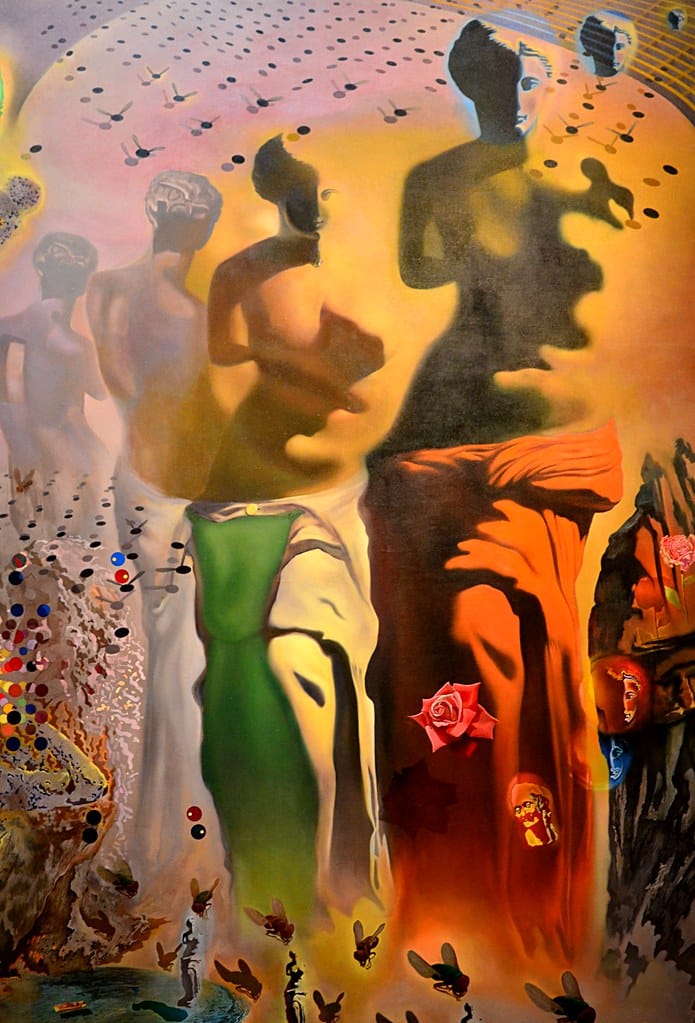
According to accounts of close friends, peers, and Dalí himself, he did not use psychedelic drugs to create his paintings. In fact, except for the occasional use of alcohol, Dalí was sober.
Dalí claimed that he acquired his trippy imagery through techniques described by Sigmund Freud, dancing the line between waking and sleeping states to capture lucid dreaming.
This may explain the symbolic, archetypal imagery and dreamlike motifs found in his artwork.
Today, magic mushroom lovers enjoy peering at Dalí’s works during a trip to connect with psychedelic sensations. As for Dalí, he created them with just his imagination!
Remarkable Magic Mushroom Artwork
There are tons of well-known artworks that illustrate either magic mushrooms in their pure form, showcase the experience of a mushroom trip, or explore hallucinations.
Take a look at a few impressive works of art that express the psychedelic effects of magical fungi.
Round-Head Art
The Round-Head art period, from about 7,000-9,000 years ago, is a remarkable collection of magic mushroom art found in caves. The works are seen to explore mystical experiences that are both ecstatic and hallucinogenic, as well as spiritual and insightful.
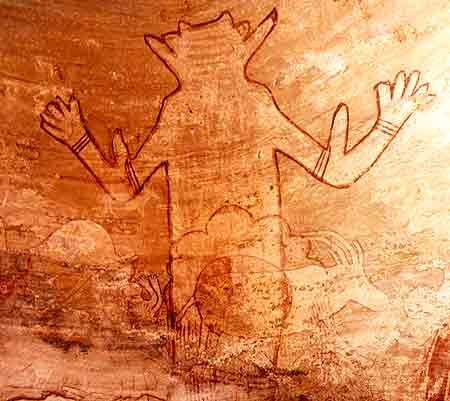
Some historians claim that these cave artworks depict the great connection between humans and nature in ancient times. The series of images show religious experiences, including masked dancers holding mushroom-shaped objects and other beings like animals or humans, being connected through those objects and geometric shapes.
This powerful insight into the interconnectivity of all beings not only demonstrates the wisdom of those tribes but it’s also a visual representation of the web of interconnectivity that mushrooms themselves embody through the mycelial network.
Fantasia by Walt Disney
The 1940’s animated film Fantasia and its related marketing graphics are well known among psychedelic astronauts to be hallucinogenic creations; even the name itself is akin to the word ‘fantasy.’
Abstract and surreal imagery, as well as flashy, bright colors, are highlighted throughout the film, matched with dramatic musical transitions. Many of the scenes are considered to demonstrate bursts of imagination, outstanding depictions, and remarkable anthropomorphic imagery that could only be explained by psychedelics.
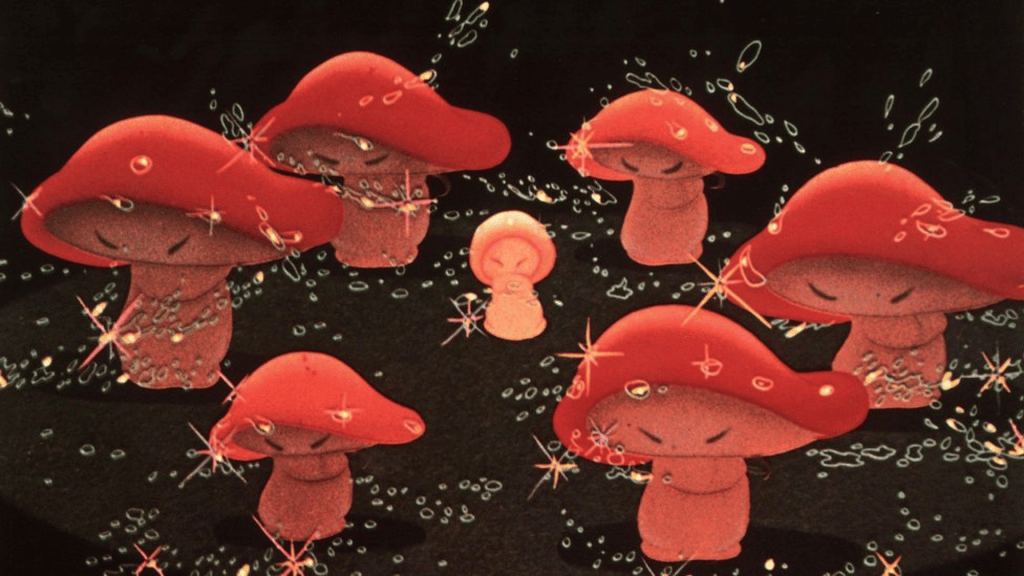
Although Disney’s intent may not have been to promote magic mushrooms, the bold colors, trippy images, and surrealist essence invited many psychedelic lovers to watch Fantasia while enjoying their trip.
Alice In Wonderland by Lewis Carroll
This classic children’s novel was written as a satire by Lewis Carroll in 1865 under the British Monarchy. Carroll not so subtly included tons of literary references to psychedelic experiences, as well as wondrous illustrations capturing trippy scenes and imaginative characters.
Some psychedelic interpretations claim that the hallucinatory style of the novel, including a hookah-smoking caterpillar, a ‘mushroom snack’ that distorts Alice’s perception of size, and an entire trip through Wonderland resemble an entire mushroom trip — specifically the Amanita muscaria mushroom.
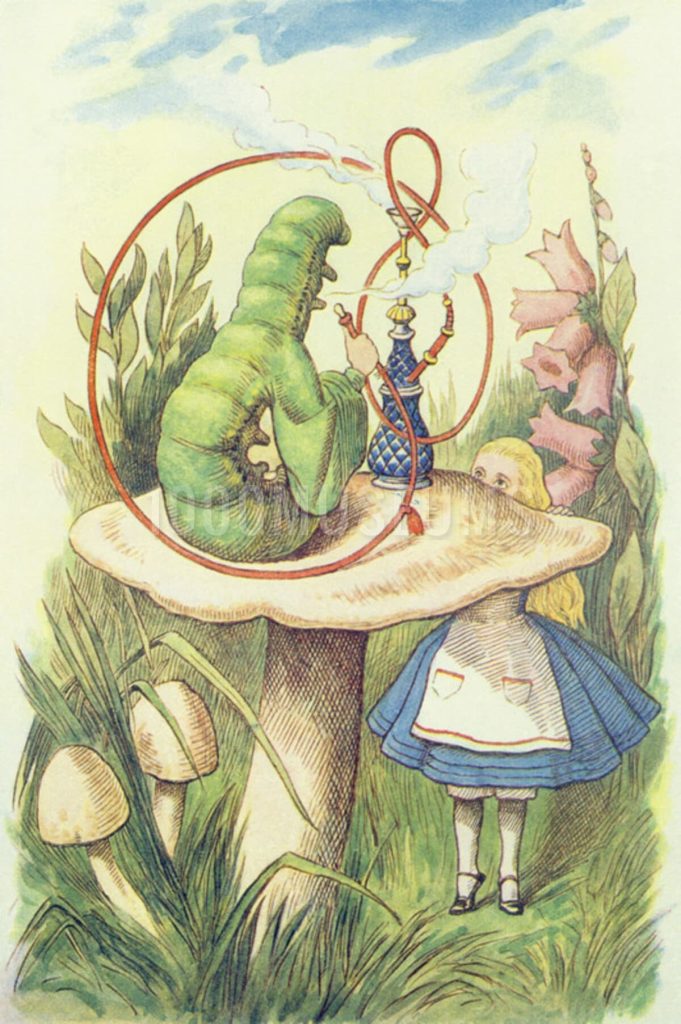
Though it is often assumed that Carroll only inadvertently incorporated so much psychedelic content in Alice In Wonderland, some theories suggest that the story makes more sense when seen as a dream, or a trip, than if taken at face value.
Setas de Sevilla
In 2011, in an incredible feat of architecture and magic, a larger-than-life building and sculptural representation of mushrooms were constructed. The monument, known as Setas de Sevilla, is the largest wooden structure in the world. What’s more? The structure is in the form of none other than one of the smallest organisms on the planet: mushrooms.
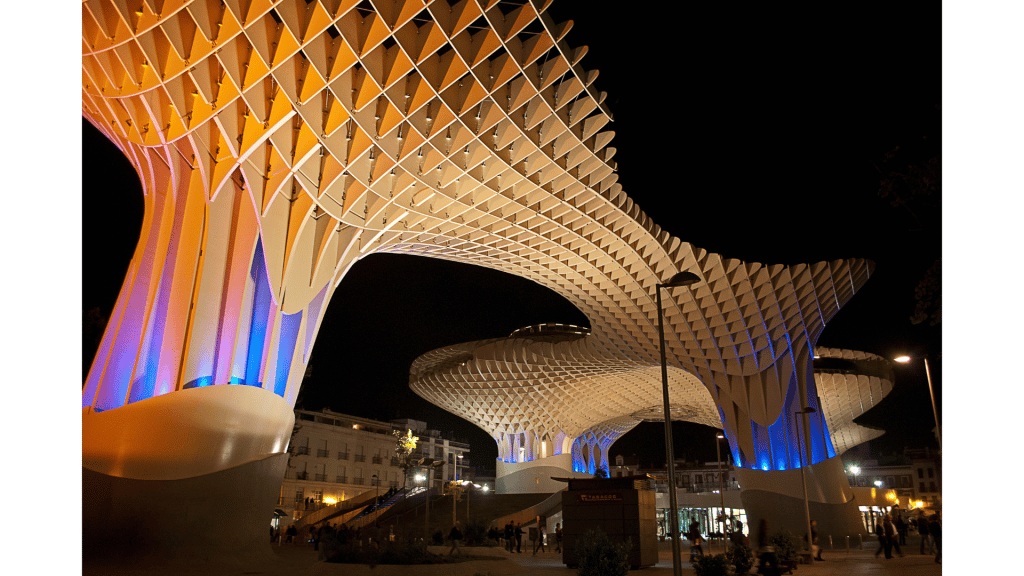
The monument, designed by architect Jürgen Mayer, has five floors and overlooks the entire city of Sevilla, Spain.
Visitors and locals have the chance to look down on the world below and perhaps get a magical glimpse of what it is like to be the size of a minuscule mushroom looking up.
This experience reflects reports of visual hallucinations [5], and visual alterations are known as Alice in Wonderland Syndrome induced by psychoactive substances that create the feeling of being either very giant or very tiny [6].
Making Art On Magic Mushrooms
Now that you’ve seen a wide variety of visual art with magic mushroom inspiration through the ages, you might be curious about how to go through your creative process while exploring a psychedelic journey.
Making art on magic mushrooms is possible but requires some discipline. Since many cognitive functions and fine motor skills are distorted throughout a magic mushroom trip, it can be hard to grasp a pen, apply paint to a canvas, or create an image that matches what you desire to express [7].
For this reason, one option is to be thoroughly present during your trip and the hallucinations. Then, when you have returned to normal, waking consciousness and regained motor functions, draw or paint the psychedelic images that you experienced.
On the other hand, if you’re keen on painting or drawing while you are tripping, it can be an interesting experiment. Be okay with however your artwork comes out, even if it’s not what you set out to create. It may take some practice to draw a captivating image while your mind is under the influence of psychedelics, especially if you are new to art-making.
Whichever route you take, a mushroom trip can greatly amplify your creativity both during and after the experience [8].
Using Psilocybin for Creative Insight
Many users self-report, and now research supports that it can be helpful to use psychedelics for creativity.
Psilocybin has been found to acutely increase spontaneous creative insights, and interestingly, post-psilocybin trip users experience an increase in novel ideas. Psychedelics can also influence aspects of the creative process, potentially pointing to magic mushrooms as a tool to investigate and strengthen creativity.
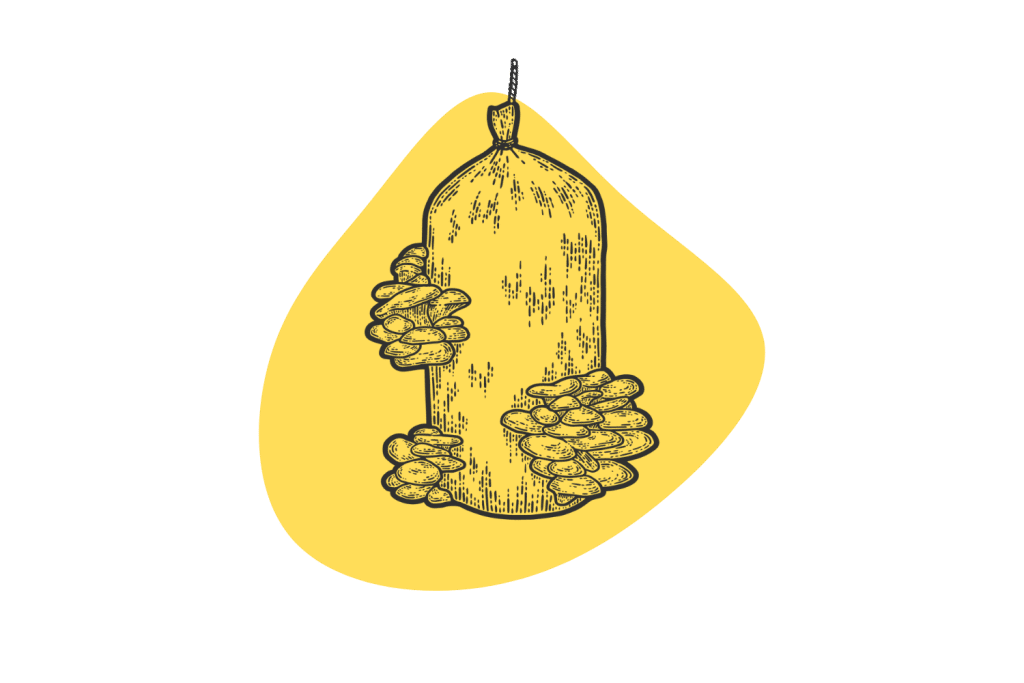
How to Draw Mushrooms
Ready to get artsy with your hallucinations? Whether you’re a practiced artist or ready to dive into something new, you can learn to draw a magic mushroom.
Here’s a step-by-step guide for drawing or illustrating your magic mushrooms.
- Draw out the stem: Create two parallel lines of equal length straight up and down on the paper.
- Draw the cap: Create a dome or half-circle shape above the stem lines. Don’t make them connect to the stem yet.
- Create the gills: Draw several lines that connect the inside of the cap to the stem.
If you want to be detailed and accurate, add some dots to the mushroom cap to represent the spores. Or, draw some marks on the stem to represent the ring, the protective outer layer of the stem.
Bonus points if you draw a psilocybin mushroom species, like the Amanita muscaria, ‘fly agaric.’ These iconic red-capped mushrooms with white spores are said to have been used by Buddhists to achieve enlightenment [9].
Here are some of our favorite tutorials to follow:
TheCreativeCove — Mushroom & Toadstool Sketches
Articco Drawing — Doodle Mushrooms
ItsyBitsy by Monitra — Doodling Different Species of Mushrooms
Final Thoughts: Magic Mushrooms in Artistic Creations
Mushrooms have been growing on this planet for tens of thousands of years, and humans have been using them for centuries for insightful, spiritual experiences and creative, recreational experiences alike.
Magic mushrooms and the resulting hallucinations they produce have been depicted in cave drawings as early as 10,000 B.C. and continue to be common motifs in contemporary art.
Tons of famous artists have explored psychedelic mushrooms and created works of art while tripping or infusing the insights and increased creativity derived from the trip into paintings after the psychedelic experience.
Many creative odes to the magical plant medicine of psychedelic experience can be found across the globe, from ancient history to the modern-day.
The best part is, it’s very likely that some incredible visual art inspired by psilocybin mushrooms has not even been created yet! Give it a whirl, and try drawing your very own magic mushroom. Perhaps the next incredible magic mushroom artist is you!
⠀⠀⠀⠀⠀⠀⠀⠀⠀⠀⠀⠀⠀⠀⠀⠀⠀⠀⣀⣴⠞⠛⠛⠛⠳⣦⣤⣄⣀⠀⢀⡀⠀⠀⠀⠀⠀⠀⠀⠀⠀⠀⠀⠀⠀⠀⠀⠀⠀⠀⠀⠀⠀⠀⠀⠀⠀⠀⠀⠀⠀⠀⠀⠀
⠀⠀⠀⠀⠀⠀⠀⠀⠀⠀⠀⠀⠀⠀⠀⠀⠀⠀⠀⢀⣀⣀⣠⣴⣶⡿⢿⣷⣤⣀⣀⣀⣴⢿⠭⣿⣟⠋⠉⠉⠙⢷⣄⠀⠀⠀⠀⠀⠀⠀⠀⠀⠀⠀⠀⠀⠀⠀⠀⠀⠀⠀⠀⠀⠀
⠀⠀⠀⠀⠀⠀⠀⠀⠀⠀⠀⠀⠀⢀⣠⣤⣄⣠⣾⠟⠋⢉⣽⣿⣻⣷⣞⠿⢼⡻⣛⢯⣞⣻⣴⡾⢿⣶⣤⣤⣀⣼⣿⢿⡶⠶⠶⢦⣄⠀⠀⠀⠀⠀⠀⠀⠀⠀⠀⠀⠀⠀⠀⠀⠀
⠀⠀⠀⠀⠀⠀⠀⠀⠀⠀⠀⠀⢠⡾⠉⣠⣼⣿⣷⢶⡟⡿⣻⣿⣻⣯⢽⣮⣶⡿⠿⢿⣴⢪⢛⣽⢲⣺⢰⢪⣻⣿⣷⡾⢿⣦⣄⣀⣽⣷⣤⣀⠀⠀⠀⠀⠀⠀⠀⠀⠀⠀⠀⠀⠀
⠀⠀⠀⠀⠀⠀⠀⠀⠀⠀⢀⣴⣿⣷⡿⣏⡗⣹⡒⣿⣶⣷⡟⣫⣿⢟⢾⣽⣦⠀⠀⢠⣿⣕⣎⢦⣓⢾⢿⣽⢚⢫⣷⢾⡻⣜⣻⣻⣿⣪⡻⣯⣍⢻⡆⠀⠀⠀⠀⠀⠀⠀⠀⠀⠀
⠀⠀⠀⠀⠀⠀⠀⠀⢀⣴⣿⣿⢟⣃⡭⣜⣰⣷⣾⠋⢉⣽⡿⢵⠲⣂⡸⣼⣿⣄⣀⣸⡿⢖⣀⢟⣾⣾⠾⢶⣦⣅⡖⢒⡪⢦⣣⣿⡞⢟⣯⢦⣻⣿⣄⣀⠀⠀⠀⠀⠀⠀⠀⠀⠀
⠀⠀⠀⠀⠀⣀⣠⣴⣿⠿⢟⠤⠏⡀⣫⠛⡟⡸⢿⣿⠻⠻⢝⡠⢭⢘⠸⠐⠜⣹⢻⢙⢻⠜⠪⡣⢽⣿⡀⠀⢹⡿⠮⢄⡊⠄⠪⣃⠾⢏⣋⣿⡟⠉⠉⠛⢿⡆⠀⠀⠀⠀⠀⠀⠀
⠀⠀⢠⣴⠟⠛⠙⢿⣯⢿⣮⢷⣥⡶⠿⠟⠾⠷⣮⣒⠡⢬⣬⡕⣍⣐⡽⠭⣔⣵⣬⣶⡭⠬⣼⣽⡮⣹⣿⠷⣿⡽⣮⣐⡎⡭⢕⢭⢮⣵⣾⠽⢷⣤⣄⣀⣼⠃⠀⠀⠀⠀⠀⠀⠀
⠀⠀⣾⠇⠀⣀⣴⡾⣟⠿⢳⣿⣷⣄⣤⣤⣤⣄⣀⣹⣿⡡⢓⣮⣛⡔⢨⣹⡾⠋⠁⢸⡿⡹⠜⣟⣘⠰⢨⡉⠌⡾⣽⣶⡿⠿⠿⠟⢛⣽⣷⣏⠟⣲⣍⡻⢿⣿⣷⣦⡀⠀⠀⠀⠀
⢀⣼⣿⡿⡿⣻⣟⡯⣿⢯⡣⣁⣄⠩⢮⢿⡷⢛⣟⠯⢡⡩⡫⢜⣶⠻⢿⣯⣄⡀⣴⠿⠥⡨⣿⢌⣠⣨⣥⠸⠙⠕⣻⡻⠿⡷⣦⡀⣹⣿⠿⡾⢟⠦⣳⣿⡾⠛⠀⠈⣿⠀⠀⠀⠀
⣸⣿⡏⢪⣿⣯⣿⣿⣏⡂⠕⠧⡏⣵⣟⣒⠿⠧⠈⣩⣊⡀⠭⠫⠼⢥⢞⢻⠹⣿⡿⢭⣿⣱⣨⣿⠟⠛⠛⢷⣯⣿⣝⢫⣔⣷⠾⣿⢿⢫⣝⣓⣪⣽⠭⠯⡷⡦⢴⣾⣿⠀⠀⠀⠀
⣾⣿⡓⣛⢿⡏⣿⣿⠋⠻⣯⡶⠏⡩⡓⢎⢯⣳⡿⠛⠙⠻⠿⣷⣵⣹⣝⢚⣭⣑⠩⢩⣝⢺⣿⣧⣀⣤⣶⣾⡹⡱⠻⢹⣟⡶⣹⣽⣿⣯⣟⣲⣿⣹⡺⠌⢟⡓⣊⣿⣿⠀⠀⠀⠀
⢻⣿⣾⡄⣞⣿⣟⣿⣶⣴⢟⠽⡽⢗⣚⣶⣾⠟⠁⠀⠀⠀⠀⣈⣿⢗⣚⢿⢾⡫⢩⢥⣒⣳⢾⡫⢽⢿⣞⣳⢶⣣⣇⣯⣾⣿⣷⣿⣿⣿⣿⣿⣿⣿⣿⣿⣿⣿⣿⣿⠏⠀⠀⠀⠀
⠀⠻⣿⣷⣤⣍⡗⣯⡿⠄⡢⣙⣇⣢⡶⠄⡏⠷⠦⣤⠤⠴⣚⢿⣽⢸⠼⢬⢛⢾⢻⢰⡴⠢⢑⣴⣿⣼⣼⣿⣿⡿⡿⢛⣻⢿⣓⡭⢿⣪⠽⢖⣩⣽⣓⣭⣿⡿⠛⠉⠀⠀⠀⠀⠀
⠀⠀⠀⠉⠛⠻⢿⣷⣷⣷⣶⣍⣳⣻⣽⣕⣳⣾⣧⣿⣾⣷⣶⣾⣶⣾⣾⣽⣶⣯⣶⣾⣶⣾⠿⣿⣿⠻⠿⠿⢶⣾⣿⣶⣾⣷⣶⡿⠷⠞⠛⠒⠛⠛⠛⠉⠁⠀⠀⠀⠀⠀⠀⠀⠀
⠀⠀⠀⠀⠀⠀⠀⠀⠈⠉⠉⠙⠛⠛⠛⠛⠋⠉⠉⠉⠀⠀⠀⠀⢈⣿⡇⠉⠉⠁⠀⠀⠀⠀⠀⠙⡿⣶⣦⡀⠀⠀⠀⠀⠀⠀⠀⠀⠀⠀⠀⠀⠀⠀⠀⠀⠀⠀⠀⠀⠀⠀⠀⠀⠀
⠀⠀⠀⠀⠀⠀⠀⠀⠀⠀⠀⠀⠀⠀⠀⠀⠀⠀⠀⠀⠀⠀⣠⣼⠟⠋⠀⠀⠀⠀⠀⠀⣀⣄⠀⢠⣦⣤⣈⡙⢶⣄⠀⠀⠀⠀⠀⠀⠀⠀⠀⠀⠀⠀⠀⠀⠀⠀⠀⠀⠀⠀⠀⠀⠀
⠀⠀⠀⠀⠀⠀⠀⠀⠀⠀⠀⠀⠀⠀⠀⠀⠀⠀⠀⠀⠀⣴⣿⣥⡴⢾⡿⣷⡀⣰⡶⣴⡟⠙⠛⢻⣿⠉⠉⠉⠉⠙⠀⠀⠀⠀⠀⠀⠀⠀⠀⠀⠀⠀⠀⠀⠀⠀⠀⠀⠀⠀⠀⠀⠀
⠀⠀⠀⠀⠀⠀⠀⠀⠀⠀⠀⠀⠀⠀⠀⠀⠀⠀⠀⠀⠀⠉⠉⠁⠀⣾⡇⠙⠿⠿⠀⠀⠀⠀⠀⢸⣿⠀⠀⠀⠀⠀⠀⠀⠀⠀⠀⠀⠀⢀⣀⠀⠀⠀⠀⠀⠀⠀⠀⠀⠀⠀⠀⠀⠀
⠀⠀⠀⠀⠀⠀⠀⠀⠀⠀⠀⠀⠀⠀⠀⠀⠀⠀⠀⠀⠀⠀⠀⠀⠀⣿⡇⠀⠀⠀⠀⠀⠀⠀⠂⠀⣿⡇⠀⢀⣀⣀⣀⣀⣤⣤⣤⣤⣿⠿⠛⠿⣦⡀⠀⠀⠀⠀⠀⠀⠀⠀⠀⠀⠀
⠀⠀⠀⠀⠀⠀⠀⠀⠀⠀⠀⠀⠀⠀⠀⠀⠀⠀⠀⠀⠀⢀⡄⠀⢀⣿⡇⠀⠀⠀⠀⠀⠀⠀⠀⠀⣿⣷⣰⠟⠉⠙⣿⡿⣟⣿⣹⣿⣧⡀⠀⢀⣼⡿⣶⣤⣤⣀⠀⠀⠀⠀⠀⠀⠀
⠀⠀⠀⠀⠀⠀⠀⠀⠀⠀⠀⠀⠀⠀⠀⠀⠀⠀⠀⠀⢀⣿⠀⢠⡿⣿⡇⠀⠀⠀⠀⠀⠀⠀⠀⠀⣿⣿⣯⣠⣤⢞⡟⣹⣾⡾⣳⠮⣤⣯⣻⣿⣓⣇⠽⣧⡀⠹⣷⠀⠀⠀⠀⠀⠀
⠀⠀⠀⠀⠀⠀⠀⠀⠀⠀⠀⠀⠀⠀⠀⠀⣀⠘⣷⣄⡼⣿⠀⣼⡇⣿⡇⠀⠀⠀⠀⠀⠀⠀⢀⣴⣿⡏⢏⣹⣴⡷⡖⣳⡷⣛⡶⠿⢶⣺⣮⣿⣷⣮⡽⣿⡛⡷⣿⡄⠀⠀⠀⠀⠀
⠀⠀⠀⠀⠀⠀⠀⠀⠀⠀⠀⠀⠀⠀⠸⣇⢹⣧⢻⣿⡇⡏⠀⡏⡇⣿⡇⠀⠀⠀⠀⠀⢀⣴⣾⣿⢹⣽⡋⠁⣙⣿⢦⣊⣹⠠⠡⣌⣲⣜⣿⡀⠀⠙⣿⢷⣐⡹⣛⣿⡄⠀⠀⠀⠀
⠀⠀⠀⠀⠀⣄⡀⣦⡀⠀⠀⠀⠀⠀⠀⣿⡄⣿⣟⣿⢳⡇⠀⣇⣿⣿⠁⠀⠀⠀⠀⢠⣿⠋⣠⣿⠸⣽⠋⠝⠉⠓⡂⢭⡑⣩⣦⡙⠒⠨⢈⠻⣦⣄⣿⢷⢿⣕⣼⣿⣇⠀⠀⠀⠀
⡀⠀⠀⠀⠀⠻⣷⣾⡿⣆⠀⣀⠀⠀⠀⢸⣿⢸⡿⣿⢸⣷⠀⢻⣿⡏⠀⠀⠀⠀⠀⠘⣿⣾⣿⣷⣠⠶⢷⣔⠀⡌⡤⣷⡋⠉⠉⠙⣷⣀⣰⡘⢖⠛⢿⣧⣇⣻⡏⠀⣿⡆⠀⠀⠀
⡇⠀⠀⠀⠀⠸⣯⣻⣿⡘⣇⠘⢷⣄⠀⠸⡿⡆⢳⣿⣸⠹⡆⢸⣿⠇⠀⠀⠀⠀⠀⠀⣿⡏⡹⣽⢣⣀⠀⢹⣿⠯⡟⣻⢷⣄⠀⢀⣾⣿⡻⣬⣷⣌⡆⠘⢃⠇⣿⣤⣽⠇⠀⠀⠀
⡇⢀⠀⠀⠀⠀⠙⣿⣿⣿⡘⣦⠈⢻⡷⣄⣷⣇⢸⡞⣿⡆⢿⣸⣿⠀⠀⠀⠀⠀⠀⠀⠻⣿⣾⣜⠒⢿⡓⢿⣻⣶⣝⣒⢿⠿⡟⢟⣿⢓⣺⡏⠀⠉⢷⣌⡆⢚⢰⣿⡇⠀⠀⠀⠀
⡇⠈⠻⣦⣄⠀⠀⠘⢯⢻⣷⠹⣦⡀⠻⡜⢿⣽⣼⢿⣹⣷⢸⣿⡏⠀⠀⠀⠀⠀⠀⠀⠀⠈⠛⠻⢿⣷⣮⣭⣥⣦⣏⣌⣱⣎⠨⢲⠾⢦⢹⣧⣀⣤⡴⠟⣁⣤⣾⣿⢃⣠⡶⠀⠀
⡇⠀⠀⠈⢿⣷⣦⡀⠘⣧⠹⣆⢻⣷⡀⠹⣦⠹⣿⠈⡏⣿⣿⣿⠀⠀⠀⠀⠀⠀⠀⠀⠁⠀⠀⠀⠀⢸⣿⣿⡿⠛⠛⠛⠛⠿⠿⣷⣾⣿⣿⣷⣼⣶⣶⣿⣿⣿⣿⣿⡿⠋⠀⠀⠀
⠷⣤⣀⡀⠀⠙⢷⣛⢷⣜⢧⠹⡄⢳⡹⣦⠘⣷⡙⣷⣿⡸⣿⡿⠀⠀⠀⠀⠠⠀⠀⠀⠀⠀⠀⠀⠀⠸⣿⣿⠃⠀⠀⠀⠀⠀⠀⠀⠀⠀⠀⡈⣿⣿⣼⢋⣴⢟⣽⠋⠀⠀⢀⣠⡼
⠀⠀⠉⠛⠿⣶⣶⣿⣧⡙⢿⣷⣻⡌⣷⡌⢷⣿⢳⡈⢻⣧⣿⣧⠀⠀⠀⠀⠀⠀⠀⠀⠂⠀⠀⠀⠀⢀⣿⣿⡀⠀⠀⠀⠀⠀⠀⠀⠀⠀⠀⠀⣿⣿⣷⠟⣰⣾⣥⣶⡶⠟⠋⠉⠀
⠀⠀⠀⠀⠀⠀⠙⢿⡽⢷⣄⠹⣿⣷⡈⢿⣄⢹⡆⢿⣆⢻⣿⣿⣦⣀⣀⣀⠀⠀⠀⣀⣀⣀⣀⣤⣵⣿⣿⣿⣧⠀⠀⠀⠀⠀⠀⠀⠀⠀⠀⣸⣿⣿⣡⣾⢟⣵⠟⠁⠀⠀⠀⠀⠀
⠀⠀⠀⠀⠀⠀⠀⠀⠹⢾⡟⠛⠛⠛⠛⠛⠙⠛⠛⠛⠙⠛⠛⠛⠛⠻⠿⠿⠿⠿⠿⠿⠿⠿⢿⠿⠿⠟⠛⢻⣿⢷⣦⣤⣤⣤⣤⣤⣤⣴⣾⣿⣿⠟⢿⣧⠞⢁⠀⠀⠀⠀⠀⠀⠀
References
- Stamets, P., & Zwickey, H. (2014). Medicinal Mushrooms: Ancient Remedies Meet Modern Science. Integrative medicine (Encinitas, Calif.), 13(1), 46–47.
- Winkelman, M. (2019). Introduction: Evidence for entheogen use in prehistory and world religions, Journal of Psychedelic Studies, 3(2), 43-62.
- Walls, A. A. (2014). Cy Twombly and the art of hunting mushrooms. American Art, 28(2), 50–69.
- Marks, L. E., & Mulvenna, C. M. (2013). Synesthesia, at and near its borders. Frontiers in psychology, 4, 651.
- Teeple, R. C., Caplan, J. P., & Stern, T. A. (2009). Visual hallucinations: differential diagnosis and treatment. Primary care companion to the Journal of clinical psychiatry, 11(1), 26–32.
- Weissenstein, A., Luchter, E., & Bittmann, M. A. (2014). Alice in Wonderland syndrome: A rare neurological manifestation with microscopy in a 6-year-old child. Journal of pediatric neurosciences, 9(3), 303–304.
- Rambousek, L., Palenicek, T., Vales, K., & Stuchlik, A. (2014). The effect of psilocin on memory acquisition, retrieval, and consolidation in the rat. Frontiers in behavioral neuroscience, 8, 180.
- Mason, N.L., Kuypers, K.P.C., Reckweg, J.T., et al. Spontaneous and deliberate creative cognition during and after psilocybin exposure. Transl Psychiatry 11, 209 (2021).
- Scott Hajicek-Dobberstein. Soma Siddhas and alchemical enlightenment: psychedelic mushrooms in Buddhist tradition, Journal of Ethnopharmacology, Volume 48, Issue 2, 1995, Pages 99-118.

